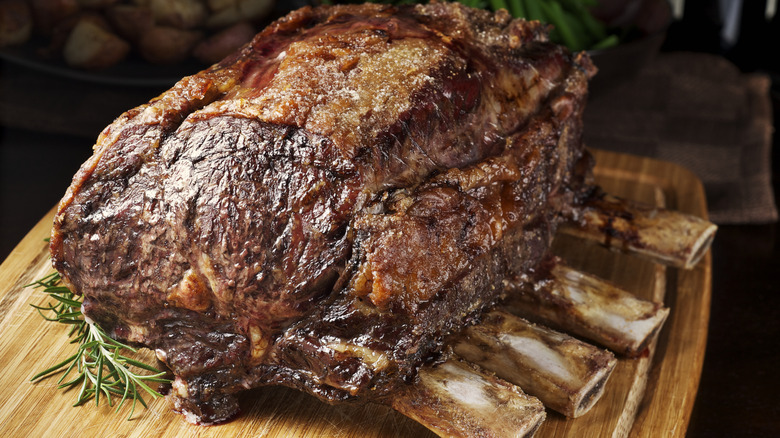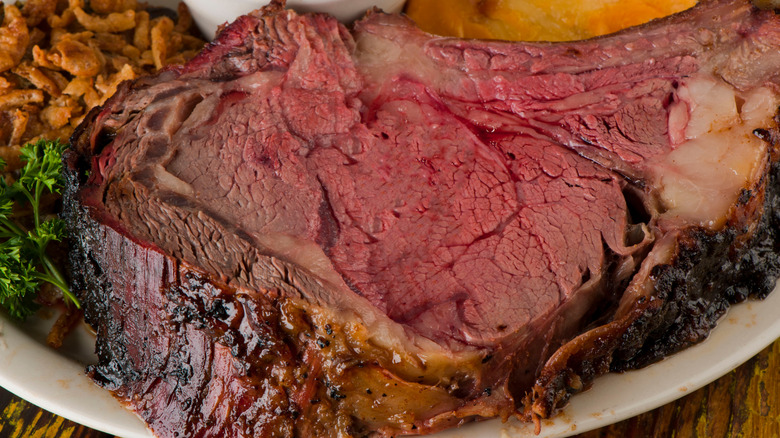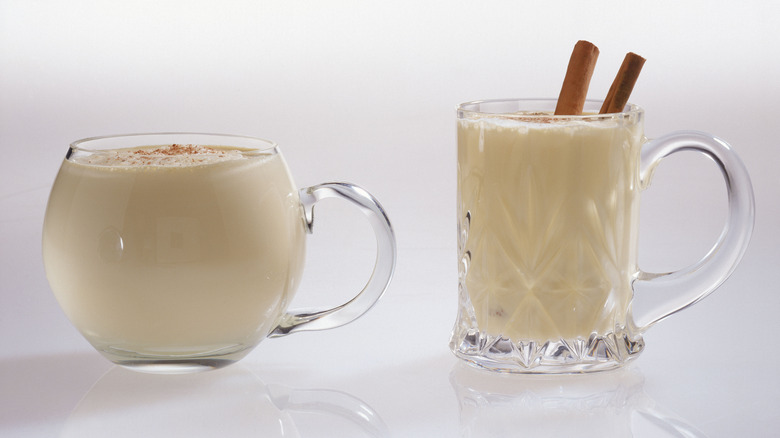Alton Brown Tells Us His Best Holiday Cooking Tips, Tricks, And Hacks - Exclusive
We may receive a commission on purchases made from links.
Alton Brown has cooked many things throughout his nearly 30-year career as a recipe developer, author, and television personality. Yet, when Tasting Table recently sat down for an exclusive interview with the "Good Eats" guy, one thing was clear: Brown has a special reverence for the foods we commonly encounter around the holidays.
The pantheon of common American seasonal dishes — turkey, rib roasts, all the fixins' — can incite salivation for basically the entire human race. To Brown, these foods are more than a delicious bite. Speaking with us just ahead of the release of his new book, "Food for Thought," and an upcoming live tour, it is clear that the potential for ritual, sanctity, and intention is a key component to the taste of the food itself. "This is Holy Grail-level stuff," Brown says, "So, I put up a lot of attention into that."
If paying attention and taking your time are not the core ingredients of your holiday meals, then it's time to add them to the grocery list. Once you've done so, Alton Brown has some thoughts on what you should do next. In some instances, guidance from the "Iron Chef" host makes a time-consuming dish faster. In others, it's all about getting to use more of the culinary tools at your disposal. (Bonus points if your smoker was a past Christmas present.) In all of Alton Brown's tips, tricks, and hacks for holiday cooking, the true gift is, as always, culinary exploration.
Spatchcock for speed
"I don't personally need the Norman Rockwell, big, round, roasted bird or turkey on the table," says Alton Brown. This is a (potentially) hot take for many Americans. But, before you go into a fit of hysterics caused by the vision of a fully-dressed festive table lacking the bulbous poultry centerpiece, you should know that Brown isn't suggesting you ditch the bird outright. He's just suggesting that you spatchcock cut yours instead.
If you're a turkey, it's no question that the Thanksgiving reaping far outranks Christmas as doomsday. Even Brown was clear in pointing out that spatchcocking is a Thanksgiving turkey tip. Still, anecdotally, Americans consume upwards of 22 million turkeys every Christmas, and it's not the only bird that benefits from being sliced and splayed. Your Thanksgiving goose, duck, chicken, or partridge can all benefit from being spatchcocked. Because spatchcocking involves cutting the breastplate and flaying the turkey out flat, you won't get the postcard presentation. What you will get is a greater exposure of skin surface area to heat, which will make the exterior more than an average bird cooked in its un-butchered shape.
The biggest motive for spatchcocking, according to Brown? "One of the main reasons is that it cooks so freaking fast," he says. "I can cook a 16-pound turkey under an hour by spatchcocking it." Again, it comes down to surface area. By laying out your bird flat, you've given more of the interior direct exposure to heat, or quicker cooking. That sounds like a reason for jubilee.
Keep the carcass (and try something new with your leftovers)
In this world, bones equal dollars, or at least they would if everyone considered them with the same value Alton Brown applies. Sure, making stock from your bird's leftovers isn't in itself a new or rare idea. But, after the greasy task of picking the carcass clean, whipping up something beyond the standard leftover sandwich can be daunting or just plain not exciting. If you do find the gumption, there's always the pull to toss in standard aromatics without much more consideration because, hey, you made it this far anyway. Looking beyond the full capabilities of your poultry carcass is a mistake, though.
For starters, Brown advises that instead of making a traditional stock, you should bubble those bones with other holiday meal leftovers. Have some extra gravy? Consider it a thickener. Did your table feature a rice dish? Use it to add body and substance. Don't be afraid to go off-script by adding some of the individual pieces that made your dishes special. "We had a sweet potato and chipotle chili dish," Brown says. "I had leftover chipotle, so I put chipotles in it."
When it comes to cooking it all together, opt for a low and slow method rather than a raging boil, and keep your soup base going by adding in some new components once a few bowls have been ladled out. Your weeklong culinary adventure may require two cups of red wine, for example. (One for you, one for the simmering pot.) "I can say in my household that turkey was consumed down to the molecule," says Brown. "Some of the bones even dissolved at that point. I like that because I typically buy one turkey a year. One. It's not because I don't like turkey, it's because I want it to be special."
A rib roast by any other name would offer less fat
The cut of beef formerly known as prime rib has been a Christmas centerpiece since the Industrial Revolution. But, the times are 'a changing. For one, recognition that the cut is actually, formally, called a standing rib roast has grown. Prime is a type of beef, after all, not a specific cut. Prime grading implies the highest quality beef with the most marbling. Choice beef is a bit more muscle, thus mid, while select beef generally implies the lowest of USDA categorization. So, what we call this Christmas tradition is shifting. How often we see it on our dining tables is also changing.
In the past few decades, Americans have been gradually cutting back on beef for nutritional reasons. At the same time, economics have affected its case. The cost of prime rib has risen roughly seven dollars per pound since the 1970s. For many of us, that puts it out of the "reasonable" price range to cook ourselves, but can make it more appealing to have at a restaurant. That said, it's a worthwhile experience to prepare this cut, and a shame that such economic barriers have developed.
One holiday cooking tip from Alton Brown offers a nice reframe of the naming problem, and a solution for the economy one: Use a USDA choice rib roast, instead. "I like choice," says Brown. "I think it's meatier." He's not making this up. Generally, prime rib cuts have a difference of three to five percent less fat — or marbling — than choice pieces. Considering that you can save between $15 and $25 per pound by opting for choice rib over prime rib, it's a worthwhile switch.
Encrust your rib roast, and use a cheese cloth
Ask him about dry brining, and Alton Brown will tell you this. "I hate that term, because there's no such thing as a dry brine. It's kind of like jumbo shrimp. It's an oxymoron," he says. So, how should we actually refer to the wildly popularized technique? "I call it a cure," he states simply. And that it is.
It's easy to conflate the two, but a dry brine is no more accurate than a "wet cure." In many cases, brining and curing have a lot of the same ingredients: salt, seasonings, and even some sugar. Both are intended to increase the flavor of your rib roast. Still, their similarities diverge when you look at the how. A brine is meant to exchange seasoned liquid with the water in animal protein cells. It keeps things juicy. A cure is meant to pull moisture out from the surface of your meat, fish, or poultry. It allows for a good, dry sear. Failing to get a crisp brown is one of the biggest mistakes of cooking rib roast, so the "Good Eats" method is to properly cure the cut.
"I completely encrust the thing with salt and cracked pepper for at least five days before I cook it," Brown says. Once the cut is coated, you'll need something to cover it that's permeable, but not too porous. For Brown, the natural choice is cheesecloth. "I can pull out as much extra moisture as possible, without actually drying the surface too much," he says.
Use a smoker to help reverse sear your rib roast
The perfect rib roast is medium rare. Obviously, this isn't a scientific fact, but it is the subjective opinion of many people including Alton Brown and this writer. Objectively, there's something that can be missed when cooking under the threshold of 130 degrees Fahrenheit. Without enough time under heat, the proteins in rare meat don't always deconstruct in a way that turns the thing before you from a hulk of flesh into appealing food. It's a rare group who like that much blood in their meal.
What science does show is that cooking to a certain degree triggers the essential changes that make meat appetizing, such as activating pyrazines and other Maillard reaction compounds. Because many Maillard compounds activate on the friable exterior of meat, it's not so hard to ignite these compounds while cooking smaller pieces of beef to a rare temp — sear the surface, keep a cool center. With something like a rib roast, however, the large size and long cooking time required can make it challenging to do effectively. For this, Alton Brown recommends using a combination of smoker and oven to achieve the (subjectively) perfect level.
A smoker likely won't be the first tool you think of when considering cooking a rib roast, but given the device's ability to hold low and slow temperatures and impart densely dark notes, it's actually more serviceable than your oven and helps to distribute the load as well. Once the roast hits around 100 degrees Fahrenheit, Brown says to rest, then roast it at 550 degrees. You can expect to lose a few ounces of water, but your cure will give you a crust that is something to chew on.
Keep those drippings for Yorkshire pudding
There are a lot of bready goods that earn a place on the American holiday table. In the South, it might be cornbread, and everyone knows the importance of a good roll cannot be overstated. The point is, baked goods aren't just side dishes, they're integral parts of the meal (and dessert, too, if we're being broad). In that sense, a lot of culinary exploration can take place, especially around baking. Yorkshire pudding is an easy one to try. It isn't inherently a holiday good, but it goes well with a standing rib roast.
Far from being gelatinous or chocolate flavored, Yorkies are like pancake batter baked into a tin. Yorkshire pudding recipes are fairly simple; the crux relies on adding batter to ripping hot oil before the pastry hits the oven. As they bake and cool, Yorkshire puddings rise and fall, resulting in a vague cup form ideal for holding gravy. Consider the sauces and gravy that typically accompany rib roast, the jus, and you can see why it's a great choice for seasonal cooking. In addition to being a vessel, your Yorkshire puddings can be composed of leftovers for a delicious twist.
"The nice thing [about rib roast] is that, of course, I harvest all the drippings and make Yorkshire pudding," says Alton Brown. Now, having some drippings from a large hunk of meat is one thing. But, having drippings from a large hunk of meat that you slowly smoked for hours? That's new territory. Divide your drippings evenly across the muffin tin before baking to impart the essence of fresh meat roasting on an open fire.
Plant-based options for eggnog (may) exist
The best parts of eggnog are the same thing that makes it a love-it-or-hate-it beverage. It's slightly sweet, unctuous, thick, velveteen. It's warming and spiced and festive. But not for all, especially those who are dairy-free. After all, these characteristics come from the marriage of milk and eggs. And though there has yet to be a non-dairy eggnog recipe that truly cracks the creamy code, Alton Brown believes it's possible ... and it won't take as long as his recipe.
"My aged eggnog is one of my favorite recipes that I've ever done, but it really does need to sit for months in the refrigerator to come to full fruition," says Brown. It makes one ask, "Who's got the time?" and also, what if I don't drink milk? Brown tells Tasting Table that although his eggnog recipes really rely on milk sugar and proteins, it may be possible to make a dairy-free version using the right experimentation with various eggnog ingredients. He recommends considering a Frankenstein of coconut and hemp milk, or even exploring the role tofu might play. Or, make an effort at hacking your way to a holiday classic: "Rice might be the way," Brown speculates. "Might almost make a congee and blend it so that you're using rice starches to replace the protein." However you approach the problem, know that it's one that Alton Brown hasn't worked out for himself yet.
A homemade dram accentuates clarified milk punch
Fortunately, seasonal cocktail choices are abundant if you didn't have the time to age yours like Alton, can't do the dairy, or simply don't jive with eggnog. Unfortunately, some of them still require milk. One such tipple is a brandy milk punch, Brown's seasonal fallback should he miss the eggnog train. There are a few ways to mix up your own brandy punch. However you do, Brown says to make sure the spices are a homemade concoction. "You've got to be willing to make your own allspice dram," he says. "It's still time-consuming, but it's a great magic trick."
Take this as a note, dear reader: "time-consuming" doesn't mean a lot of active effort. Most of the time involved comes after the toasted allspice berries are crushed, steeped, and rested with a "navy strength" rum. Following those three steps, it's roughly a week of waiting for infusion to occur, then straining, heating, and adding sugar. The resulting beverage is used to clarify the milk by causing curdling (with the addition of lemon). It's a deliciously smooth beverage made all the better by a little science.
Purchase Alton Brown's new book, "Food For Thought," on Amazon. You can also catch Alton Brown: Live on tour in 2025.








